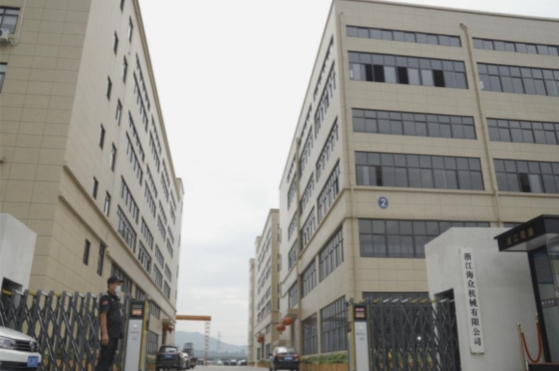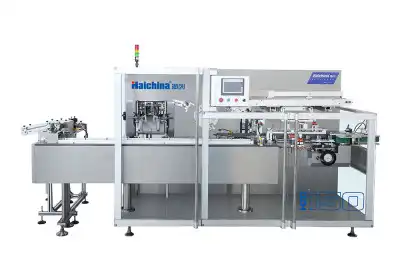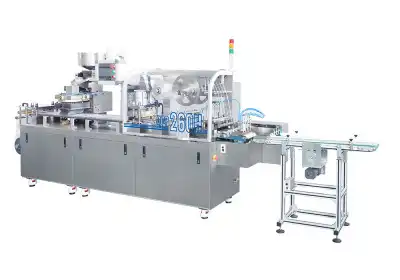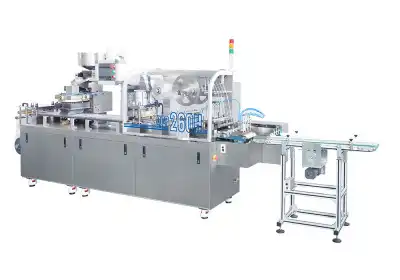Key Features to Look for in a Pharma Blister Packaging Machine
When selecting a pharma blister packaging machine, it's crucial to consider several key features that ensure optimal performance, efficiency, and compliance with industry standards. These machines play a vital role in the pharmaceutical packaging process, protecting medications from environmental factors while providing tamper-evident packaging. The ideal blister packaging equipment should offer precision, versatility, and reliability. Look for machines that incorporate advanced sealing technology, accurate dosing mechanisms, and user-friendly interfaces. Additionally, ensure the equipment meets cGMP requirements and can handle various blister materials and product formats. By carefully evaluating these features, pharmaceutical manufacturers can select a blister packaging solution that enhances their production capabilities and maintains product integrity.

Essential Components of High-Quality Blister Packaging Equipment
Precision Forming and Sealing Mechanisms
The heart of any efficient pharma blister packaging machine lies in its forming and sealing mechanisms. Advanced systems utilize precise temperature control and pressure distribution to create consistently shaped blisters. Look for machines equipped with servo-driven forming stations that offer adjustable depth and contour options. High-quality sealing plates ensure airtight closures, protecting pharmaceuticals from moisture and oxidation. Some cutting-edge models incorporate ultrasonic sealing technology, which provides superior seal integrity without excessive heat exposure.
Versatile Product Feeding Systems
A top-tier blister packaging solution should feature versatile feeding systems capable of handling various pharmaceutical formats. Look for machines with interchangeable feeding modules that can accommodate tablets, capsules, soft gels, and even liquids. Advanced vibratory feeders with vision systems ensure accurate product placement and can detect and reject malformed or broken items. Some high-end models offer multi-lane feeding capabilities, significantly boosting production rates without compromising accuracy.
Integrated Quality Control Features
To maintain compliance with stringent pharmaceutical regulations, modern blister packaging equipment often incorporates integrated quality control features. These may include in-line weight checking systems, vision inspection cameras for detecting missing or incorrect products, and seal integrity testers. Look for machines that offer real-time data logging and reporting capabilities, allowing for comprehensive batch documentation and traceability. Some advanced systems even incorporate artificial intelligence algorithms to continuously optimize packaging parameters and detect potential issues before they impact production.
Enhancing Efficiency and Flexibility in Pharmaceutical Packaging
Rapid Changeover Capabilities
In today's fast-paced pharmaceutical manufacturing environment, the ability to quickly switch between different product runs is invaluable. A state-of-the-art pharma blister packaging machine features tool-less changeover systems, allowing operators to swap out format parts and adjust settings with minimal downtime. Look for equipment with modular design elements that facilitate easy cleaning and maintenance between batches. Some advanced models of pharma blister packaging machines offer recipe management systems that can store and recall specific product parameters, further streamlining the changeover process.
Integration with Downstream Equipment
To maximize production efficiency, consider blister packaging machines that seamlessly integrate with downstream equipment such as cartoners and case packers. Look for systems that offer standardized communication protocols and can synchronize operations across the entire packaging line. Some manufacturers provide comprehensive packaging solutions that include blister formation, product insertion, sealing, and cartoning in a single, integrated unit. This approach can significantly reduce floor space requirements and minimize the need for manual product handling.
Energy Efficiency and Sustainability Features
As the pharmaceutical industry increasingly focuses on sustainability, energy-efficient blister packaging equipment has become a priority. Look for machines that incorporate energy-saving features such as servo-driven motors, regenerative braking systems, and intelligent power management. Some advanced models utilize heat recovery systems to redirect waste heat from sealing stations, reducing overall energy consumption. Additionally, consider equipment designed to work with eco-friendly blister materials, such as recyclable or biodegradable films, to further enhance your company's environmental credentials.
Ensuring Compliance and Traceability in Pharmaceutical Packaging
cGMP Compliance and Validation Support
When selecting a pharma blister packaging machine, compliance with current Good Manufacturing Practices (cGMP) is non-negotiable. Look for equipment that is designed and manufactured in accordance with cGMP guidelines and offers comprehensive validation support. This should include detailed documentation, such as Installation Qualification (IQ), Operational Qualification (OQ), and Performance Qualification (PQ) protocols. Some manufacturers provide on-site validation services to ensure your equipment meets all regulatory requirements from day one.
Serialization and Track-and-Trace Capabilities
With increasing regulatory demands for product traceability, modern blister packaging equipment often incorporates serialization and track-and-trace features. Look for machines that can apply unique identifiers to individual blisters or cartons, such as 2D data matrix codes or RFID tags. Advanced systems offer integration with enterprise-level serialization software, allowing for end-to-end tracking of pharmaceutical products throughout the supply chain. Some cutting-edge models even incorporate blockchain technology to enhance data security and authenticity verification.
Data Management and Analytics
To optimize production processes and ensure regulatory compliance, robust data management capabilities are essential. Look for blister packaging machines that offer comprehensive data logging and analysis tools. Advanced systems may include real-time performance monitoring dashboards, predictive maintenance algorithms, and integration with Manufacturing Execution Systems (MES). Some manufacturers provide cloud-based analytics platforms that allow for remote monitoring and benchmarking across multiple production sites, facilitating continuous improvement initiatives.
Conclusion
Selecting the right pharma blister packaging machine is crucial for pharmaceutical manufacturers looking to optimize their production processes, ensure product quality, and maintain regulatory compliance. By focusing on key features such as precision forming and sealing mechanisms, versatile feeding systems, and integrated quality control features, companies can enhance their packaging capabilities. Additionally, considering factors like rapid changeover capabilities, energy efficiency, and advanced traceability features will help ensure long-term success in an ever-evolving industry. As technology continues to advance, staying informed about the latest innovations in blister packaging equipment will be essential for maintaining a competitive edge in the pharmaceutical market.
FAQs
What is the typical output rate of a modern pharma blister packaging machine?
Output rates can vary widely depending on the specific model and configuration. High-speed machines can produce up to 600 blisters per minute, while smaller units may operate at 60-120 blisters per minute.
How important is cleanroom compatibility for blister packaging equipment?
Cleanroom compatibility is crucial for many pharmaceutical applications. Look for machines designed with smooth surfaces, minimal crevices, and materials that resist particle generation and are easy to clean and sanitize.
Can blister packaging machines handle both PVC and aluminum foil materials?
Yes, many modern machines are designed to work with a variety of blister materials, including PVC, PVDC, COC, and aluminum foil. Ensure the equipment you choose is compatible with your specific packaging requirements.
Key Features to Look for in a Pharma Blister Packaging Machine | Haichina
At Haichina, we are a trusted pharma blister packaging machine manufacturer and understand the critical role that blister packaging plays in pharmaceutical production. As a leading manufacturer of packaging equipment, we offer customizable solutions to meet your specific needs. Our machines are CE-certified, cGMP-compliant, and backed by our experienced technical support team. For cutting-edge blister packaging technology that enhances your production efficiency and product quality, contact our factory at [email protected].
References
Johnson, M. (2023). Advances in Pharmaceutical Packaging Technology. Journal of Drug Delivery Science and Technology, 68, 103-115.
Smith, A. et al. (2022). Quality Control in Blister Packaging for Pharmaceuticals. International Journal of Pharmaceutics, 615, 121-133.
Pharmaceutical Manufacturing and Packaging Sourcebook. (2023). Blister Packaging Equipment: Trends and Innovations. 15th Edition, 78-92.
European Medicines Agency. (2022). Guideline on the Manufacture of the Finished Dosage Form. EMA/CHMP/QWP/245074/2015.
Brown, L. (2023). Energy Efficiency in Pharmaceutical Packaging Operations. Sustainability in Pharma Manufacturing, 2nd Edition, 156-170.
World Health Organization. (2022). WHO Technical Report Series: Annex 2 - Good Manufacturing Practices for Pharmaceutical Products. No. 986.

Submit the form now to get a unique quote!

ZHEJIANG HAIZHONG MACHINERY CO., LTD.
Popular Blogs
-
 Successful caseProducts and services
Successful caseProducts and servicesHow to Train Employees to Operate a Bottle Packing Machine Effectively?
-
 Successful caseIndustry insights
Successful caseIndustry insightsThe Blister Packaging Process: A Complete Step-by-Step Guide
-
 Successful caseComparative analysisIndustry insights
Successful caseComparative analysisIndustry insightsWhat Type of PVC Is Best for Blister Packing Machines?